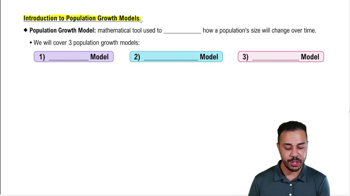Table of contents
- 1. Introduction to Biology2h 42m
- 2. Chemistry3h 40m
- 3. Water1h 26m
- 4. Biomolecules2h 23m
- 5. Cell Components2h 26m
- 6. The Membrane2h 31m
- 7. Energy and Metabolism2h 0m
- 8. Respiration2h 40m
- 9. Photosynthesis2h 49m
- 10. Cell Signaling59m
- 11. Cell Division2h 47m
- 12. Meiosis2h 0m
- 13. Mendelian Genetics4h 44m
- Introduction to Mendel's Experiments7m
- Genotype vs. Phenotype17m
- Punnett Squares13m
- Mendel's Experiments26m
- Mendel's Laws18m
- Monohybrid Crosses19m
- Test Crosses14m
- Dihybrid Crosses20m
- Punnett Square Probability26m
- Incomplete Dominance vs. Codominance20m
- Epistasis7m
- Non-Mendelian Genetics12m
- Pedigrees6m
- Autosomal Inheritance21m
- Sex-Linked Inheritance43m
- X-Inactivation9m
- 14. DNA Synthesis2h 27m
- 15. Gene Expression3h 20m
- 16. Regulation of Expression3h 31m
- Introduction to Regulation of Gene Expression13m
- Prokaryotic Gene Regulation via Operons27m
- The Lac Operon21m
- Glucose's Impact on Lac Operon25m
- The Trp Operon20m
- Review of the Lac Operon & Trp Operon11m
- Introduction to Eukaryotic Gene Regulation9m
- Eukaryotic Chromatin Modifications16m
- Eukaryotic Transcriptional Control22m
- Eukaryotic Post-Transcriptional Regulation28m
- Eukaryotic Post-Translational Regulation13m
- 17. Viruses37m
- 18. Biotechnology2h 58m
- 19. Genomics17m
- 20. Development1h 5m
- 21. Evolution3h 1m
- 22. Evolution of Populations3h 52m
- 23. Speciation1h 37m
- 24. History of Life on Earth2h 6m
- 25. Phylogeny2h 31m
- 26. Prokaryotes4h 59m
- 27. Protists1h 12m
- 28. Plants1h 22m
- 29. Fungi36m
- 30. Overview of Animals34m
- 31. Invertebrates1h 2m
- 32. Vertebrates50m
- 33. Plant Anatomy1h 3m
- 34. Vascular Plant Transport1h 2m
- 35. Soil37m
- 36. Plant Reproduction47m
- 37. Plant Sensation and Response1h 9m
- 38. Animal Form and Function1h 19m
- 39. Digestive System1h 10m
- 40. Circulatory System1h 57m
- 41. Immune System1h 12m
- 42. Osmoregulation and Excretion50m
- 43. Endocrine System1h 4m
- 44. Animal Reproduction1h 2m
- 45. Nervous System1h 55m
- 46. Sensory Systems46m
- 47. Muscle Systems23m
- 48. Ecology3h 11m
- Introduction to Ecology20m
- Biogeography14m
- Earth's Climate Patterns50m
- Introduction to Terrestrial Biomes10m
- Terrestrial Biomes: Near Equator13m
- Terrestrial Biomes: Temperate Regions10m
- Terrestrial Biomes: Northern Regions15m
- Introduction to Aquatic Biomes27m
- Freshwater Aquatic Biomes14m
- Marine Aquatic Biomes13m
- 49. Animal Behavior28m
- 50. Population Ecology3h 41m
- Introduction to Population Ecology28m
- Population Sampling Methods23m
- Life History12m
- Population Demography17m
- Factors Limiting Population Growth14m
- Introduction to Population Growth Models22m
- Linear Population Growth6m
- Exponential Population Growth29m
- Logistic Population Growth32m
- r/K Selection10m
- The Human Population22m
- 51. Community Ecology2h 46m
- Introduction to Community Ecology2m
- Introduction to Community Interactions9m
- Community Interactions: Competition (-/-)38m
- Community Interactions: Exploitation (+/-)23m
- Community Interactions: Mutualism (+/+) & Commensalism (+/0)9m
- Community Structure35m
- Community Dynamics26m
- Geographic Impact on Communities21m
- 52. Ecosystems2h 36m
- 53. Conservation Biology24m
6. The Membrane
Biological Membranes
Problem 2`
Textbook Question
According to the fluid mosaic model of membrane structure, proteins of the membrane are mostly
a. Spread in a continuous layer over the inner and outer surfaces of the membrane.
b. Confined to the hydrophobic interior of the membrane.
c. Embedded in a lipid bilayer.
d. Randomly oriented in the membrane, with no fixed inside-outside polarity.
 Verified step by step guidance
Verified step by step guidance1
Understand the fluid mosaic model: This model describes the structure of cell membranes as a mosaic of components, including lipids, proteins, and carbohydrates, which gives the membrane a fluid character.
Identify the main components of the membrane: The membrane is primarily composed of a lipid bilayer, which provides a flexible matrix and serves as a barrier to the passage of molecules.
Consider the role of proteins in the membrane: Proteins are embedded within the lipid bilayer and can move laterally, contributing to the fluid nature of the membrane.
Evaluate the options given: Analyze each option to determine which best describes the arrangement of proteins according to the fluid mosaic model.
Select the correct option: Based on the understanding that proteins are embedded within the lipid bilayer, choose the option that accurately reflects this aspect of the fluid mosaic model.
 Verified video answer for a similar problem:
Verified video answer for a similar problem:This video solution was recommended by our tutors as helpful for the problem above
Video duration:
2mPlay a video:
Was this helpful?
Key Concepts
Here are the essential concepts you must grasp in order to answer the question correctly.
Fluid Mosaic Model
The fluid mosaic model describes the structure of cell membranes as a dynamic and flexible arrangement of lipids and proteins. In this model, the membrane is composed of a lipid bilayer with proteins embedded within it, allowing for lateral movement. This structure enables the membrane to be fluid, facilitating various cellular processes such as transport and signaling.
Recommended video:
Guided course

Introduction to Population Growth Models
Lipid Bilayer
The lipid bilayer is a fundamental component of the cell membrane, consisting of two layers of phospholipids. Each phospholipid has a hydrophilic head and hydrophobic tail, creating a barrier that separates the cell's interior from its external environment. This bilayer provides structural integrity and regulates the passage of substances in and out of the cell.
Recommended video:
Guided course

Lipids
Membrane Proteins
Membrane proteins are integral or peripheral proteins that are embedded within or attached to the lipid bilayer. They play crucial roles in various functions such as transport, signal transduction, and cell recognition. In the fluid mosaic model, these proteins are not fixed but can move laterally within the lipid bilayer, contributing to the dynamic nature of the membrane.
Recommended video:
Guided course

Types of Membrane Proteins
Related Videos
Related Practice
















